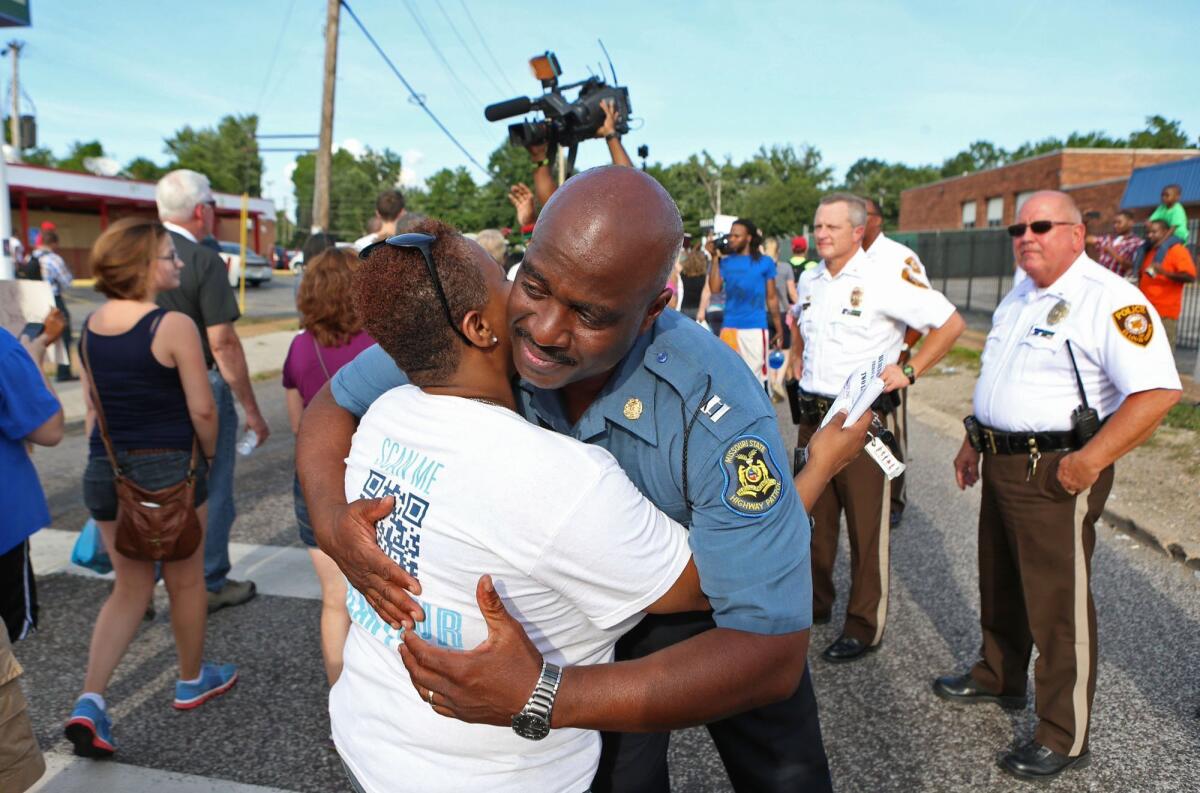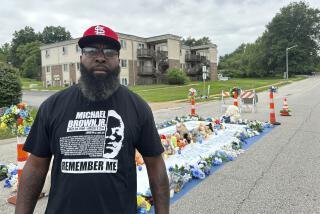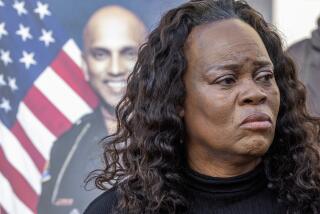In troubled Ferguson, police try a gentler approach

- Share via
Reporting From Ferguson, Mo. — St. Louis Police Sgt. Robert Ogilvie was getting off work late when he got the call from his boss to come join the new night patrol in this riot-ravaged suburb.
After days of protesters clashing with local police after the shooting of Michael Brown, an 18-year-old African American, the governor had directed the state Highway Patrol to take over security in Ferguson.
The Highway Patrol is headed by Ron Johnson, who enlisted Ogilvie’s boss, Maj. Ronnie Robinson, to bring order to the suburb where a majority of the population is black and much of the city’s power structure, including the police department, is white. Johnson, Robinson and Ogilvie are African American.
So at 6 p.m. Thursday, Ogilvie and Robinson set out on foot in Ferguson to diffuse racial tension, one bystander at a time.
“It’s not always showing force,” said Ogilvie, a trim 48-year-old officer with shaved, graying hair and a thick mustache. “Sometimes you have to show compassion.”
This is what Ogilvie and Robinson had learned to do at the police academy where they were classmates 23 years ago: Walk with the people, listen to their problems, let them set the agenda. Community Policing 101.
Ideally, they would have made the rounds Thursday night in civilian clothes. But neither had time to change. They walked West Florissant Avenue conspicuously in uniform, Robinson in a dress cap and bright white shirt, Ogilvie in blue. Underneath, he still wore a bulletproof vest he knew he would not need.
This crowd posed no threat, he said to himself. They wanted an officer to talk to, not to attack.
Just then some young men in a passing car shouted the F-bomb, a common refrain aimed at police this week on the avenue.
Robinson, also 48, waved and shouted a greeting, unfazed. In response, the men chuckled.
“They’re laughing. They don’t expect the police to speak to them,” he said as he walked past a McDonald’s, a pawn shop and a furniture rental store. “Some kids — you’ve got to communicate.”
A black biker zooming past spotted Robinson, slowed and smiled, shouting, “Hey Ronnie!”
Robinson waved.
The 48-year-old Robinson had become a police officer, he said, because he believed in fairness. He attended high school not far from here, the same school attended by Brown, whose fatal shooting Saturday outside the QuikTrip gas station down the avenue sparked looting. A few of the businesses Robinson now passed were still battered and boarded up with plywood.
Many of the bystanders who lined the avenue Thursday night had also traveled from St. Louis to bear witness, familiar faces in neighborhoods Ogilvie and Robinson have policed for years. Ogilvie saw a few whom he had arrested.
About 8 p.m., a police cruiser suddenly zoomed up the street toward the charred hulk of the QuikTrip, where the crowd was thickest and most raucous. The cruiser arrived with lights flashing, sirens blaring.
A woman had fallen and needed medical attention. Ogilvie and Robinson wished their colleagues had sent an ambulance, or at least turned off the lights and sirens. Some onlookers started throwing bottles.
The pair tried to steer the crowd away from the police car. Older residents helped, including a man dressed in a suit and carrying a bullhorn. The crowd obeyed, and police drove the woman back to their nearby command center to get treated.
The Rev. Gill Ford was impressed.
“People are seeing a difference,” said Ford, national director for the NAACP in Baltimore, who arrived here after the shooting.
Still, he cautioned, “you can only take it one day at a time.”
Ogilvie and Robinson went back to walking West Florrisant, slowly. They shook hands and listened as residents vented their frustration with local police, everything from racial profiling to pernicious traffic tickets. One woman spent 15 minutes complaining to Ogilvie about getting ticketed outside of her own home. Just days earlier, Ferguson police had fired rubber bullets and rounds of gear gas.
Ogilvie and Robinson stopped to talk to a young woman with short blond dreadlocks who turned out to be a cousin of Brown.
Robinson gave her his condolences. And he promised police would work for justice for her family, to ensure that the truth of what happened to her cousin would be revealed.
Sabrina Webb, 22, walked away feeling a bit better.
“They’re going to do all they can,” Webb said. “To see that someone from the police actually cares, it brings a lot of relief.”
At one point, the officers were joined on the avenue by Johnson, the Highway Patrol chief, a tall, trim figure, also in uniform. He walked the crowd alongside St. Louis County Police Chief Joe Belmar, who is white.
Tammy Finley-Stewart, 31, was excited to see Johnson — the first African American officer she had seen since moving here from Chicago four years ago.
“We do not have confidence in our justice system, our police, that they are going to protect us and serve us,” said Finley-Stewart, who was wearing a T-shirt that said, “Don’t shoot.”
“You can’t serve somebody who doesn’t trust you,” she said.
Robinson said their approach wasn’t just about race, it was about empathy, sincerity. Half the officers who graduated in their academy class were white.
“If you give respect, you will receive respect,” he said.
Ogilvie had followed an older cousin onto the police force, a mentor who’s also still serving. He figures Ferguson police would benefit from having more African American officers — of 53 commissioned officers on the force, three are black — but that white officers can do the same outreach. He saw them do it while working on a gang task force.
“Once you realize you’re part of the community, it changes everything,” he said.
Many of those Ogilvie talked to on the avenue asked what he thought of the shooting. He refused to blame the police officer involved, advising people to wait for all of the evidence to be analyzed.
He urged those who witnessed it to come forward and aid investigators, not to fear being derided by neighbors for snitching. He has two grown sons and sympathized with Brown’s family.
Ogilvie also knows what it’s like to be on the other side of that gun.
Back in 1994, he was in a shootout with a fleeing robbery suspect. Ogilvie didn’t shoot the man, who was from Ferguson. But he was hit twice, once in each leg, through and through. A jury found the shooter not guilty. Three months later, Ogilvie was back on the job.
By 10:30 p.m. Thursday, Ogilvie and his boss were still walking, his legs aching.
They have responded to scores of shootings, scores of funerals where tension was high. He thought of the neighborhood shrines erected for the fallen, and what would happen if they were swept away.
The crowds on West Florissant Avenue might linger for days, lifting their arms and shouting “Don’t shoot!” in homage to Brown. This place had become their shrine.
“Give them a chance to mourn,” he advised. “You might get some peace.”
The next morning, authorities would finally reveal the name of the officer who shot Brown — Darren Wilson — and say that Brown had been a suspect in the robbery of convenience store. Ferguson residents would react with skepticism, expressing disbelief that Brown had been involved in any wrongdoing.
But on this night, the moon was high in the sky, the air on the avenue cool, smelling of fresh cut grass and marijuana. The street was still full of protesters, mostly young people shouting and honking, some toting beers and liquor bottles.
But there had been no violence, no looting. Shortly before midnight the officers headed home, exhausted and relieved.
Follow @mollyhf for national news.
More to Read
Sign up for Essential California
The most important California stories and recommendations in your inbox every morning.
You may occasionally receive promotional content from the Los Angeles Times.











